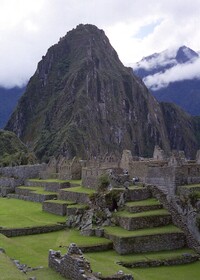Photo. Machu Picchu - built with a symbolic purpose? What is the shape of Machu Picchu? Condor, puma or something else? Anyway I am sure the Incas had a architectural plan. © Travel Explorations.
What do you picture when you think of Machu Picchu? Think about that it was built without use of mortar, metal tools, or the wheel. More than 200 buildings sit atop the mountain. This demonstrates the Incas’ deep knowledge of architecture, agriculture, engineering, and astronomy. It made me attracted to Machu Picchu. It seemed to be so fascinating - like a fairytale world. Therefor I visited the place in July 2002.
Macchu Picchu is shrouded in historical mystery. Finally I was there. It was early in the morning. The sun rose and the fog disappeared, Machu Picchu revealed in its natural beauty surroundings – totally in harmony with its environment. The site is divided into two main areas: the agricultural sector, with terraces carved into the hillside to prevent erosion and provide farmland, and the urban sector, which includes residential areas, plazas, and religious and ceremonial buildings.
My thoughts started to spin about the creation of this wonder. I wonder, where did the Incas‘ get their knowledge from and how did they built Machu Picchu? These questions challenge me trying to understand what was possible in ancient times. And when I visit ancient sites in general, I like to study the history and try to see behind the “facade”. Often it`s more to the picture than the eyes can see. Machu Picchu is definitely a place like this. By looking at the details, I understood that the Incas must be very advanced in engineering.
Walking around in the site was awe inspiring at each step and in every corner. And I think when they built it, it had a symbolic meaning. The secrets of Machu Picchu aren't limited to architecture. They reveal insights into the Inca's beliefs and rituals. So therefor the construction of the site has has to be considered in a bigger context. Experience Machu Picchu was so evocative that it was almost a letdown for me to return to the "real world" again.
How were cities built in ancient times? Did people plan them or just build them wherever they could find space for buildings? During the time when some ancient civilizations were building pyramids, other civilizations building different types of grand architecture? Several buildings constructed in ancient times are renowned for their impressive architectural skills. Some of them are the Great Pyramid of Giza in Egypt, Taj Mahal in India, the Colosseum in Rome, Newgrange in Ireland, Persepolis Gate of Nations in Iran, Angkor Wat in the heart of Cambodia, Greek Parthenon on the Acropolis, and the Great Wall of China. These structures showcase the advanced engineering and architectural knowledge of ancient civilizations. It remind me that I shouldn`t underestimate people in the past. In some ways I think they where even more advance than our “civilization” today, and unfortunately much of their knowledge is lost through time.
Machu Picchu, often referred to as the "Lost City of the Incas," is a 15th-century Inca citadel located in the Eastern Cordillera of southern Peru on a 2,430-meter (7,970 ft) mountain ridge. It's one of the most iconic symbols of the Incan Empire and a UNESCO World Heritage Site.
Machu Picchu still holds many secrets and mysteries. Ongoing archaeological excavations continue to reveal new findings at Machu Picchu, offering insights into Inca culture, engineering, architecture, agriculture, astronomy, and daily life. Each discovery helps to piece together the history of this magnificent site, but also raises new questions.
Imagine building Machu Picchu, it was like solving a huge, complex puzzle, where every piece had to fit perfectly into place. First of all, I believe the Incas‘ had a comprehensive plan for the construction of the city – actually a long-term strategic plan for the city with vision of where the community wants to be at some point in the future.
The Incas selected a strategic and sacred location for Machu Picchu, between two mountain peaks and above a loop of the Urubamba River. The site's natural defences and its nearness to other Incan sites made it an ideal choice.
The original purpose of Machu Picchu remains a topic of scholarly debate. While it's common accepted that it was a royal estate for the Inca emperor Pachacuti. Some other theories suggest it may have served as a ceremonial site, a military stronghold, or even a retreat for ruling elites. Its strategic location and architectural layout indicate that it had a multifunctional significance.
The construction of Machu Picchu showcases the Incas' sophisticated engineering skills. They developed advanced techniques to ensure water supply, agriculture, and stability of structures on the steep mountain terrain. For example, they constructed a network of channels for water drainage and terraces for agriculture, demonstrating their understanding of the environment and hydrology.
Machu Picchu's design aligns with astronomical events, such as the solstices and equinoxes. Especially I was fascinated by the so called Intihuatana stone ("Hitching Post of the Sun"), which was believed to have been used as a astronomical clock or calendar. This construction is one of Machu Picchu's most mysterious features. It's thought to have been used as a sundial or to hold the sun in its place at certain times of the year. The precision with which it was carved to align with the sun's movements is still admired today.
How do they managed to create one of the most impressive architectural achievements without the use of modern tools or technology? The methods used to build this ancient city, nestled high in the Andes Mountains, still need.
Briefly, that`s the way Machu Picchu was built:
- Transportation of materials must be a huge effort. Moving these heavy stones up the mountainous terrain would have required tremendous manpower and ingenuity. Built without the use of wheels, hundreds of men pushed the heavy rocks up the steep mountain side.
- Structures at Machu Picchu were built with a technique called “ldquo ashlar.” Stones are cut to fit together without mortar. Cutting and shaping of stones are made so precisely that they fit together without mortar. The stones are so tight assembled that not even a knife blade can fit through them. This makes the constructions very stable against earthquakes.
- Building deep foundations and engineered an extensive drainage system to protect the city from flooding.
- Use of trapezoidal shapes for doors, windows, and niches, for protection against seismic activity.
- Preserving existing rock formations and incorporated them into the city's layout. Merged the architecture with the surrounding landscape.
There are no written records of how Machu Picchu was built. Exploring the site, is as mentioned, a huge puzzle putting the pieces together step for step.
Thinking too much of how it was built might overload the brain. Sometimes it`s just better to enjoy the wonder and the beautiful surroundings.
Stein Morten Lund
Updated 22nd March 2024
Additional information
Note: This article is written with assistance from ChatGTP and use of information sources as Wikipedia.
10 Best Ancient Structures We Still Don’t Understand in 2021
The World’s 20 Most Impressive Ancient Builds












